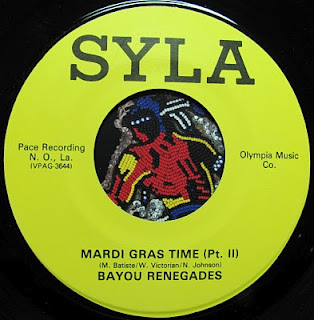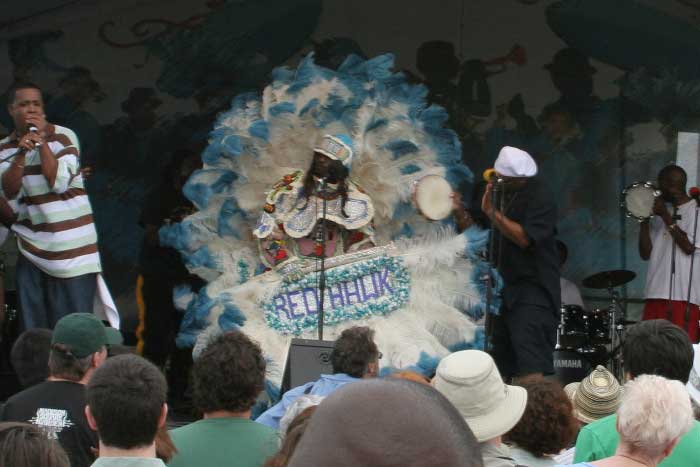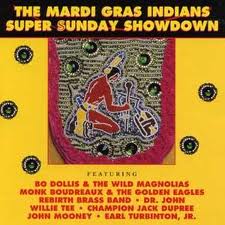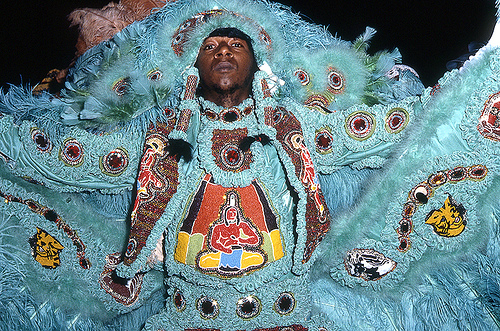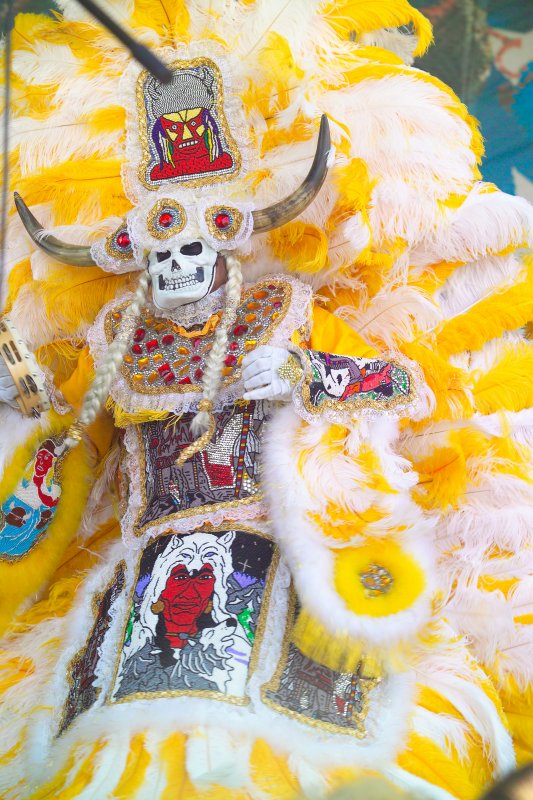Posts tagged June Victory
Indians Building Peace Pact with NOPD!!
0This is the first story I can place on both my blogs! That’s great and weird. I’ve got the Mardi Gras Indians angle for this blog, and the NOPD for my watchopp blog, or Watch Orleans Parish Prison. Never thought this would happen, and I never thought of this happening ever. So from my point of view, I’m killing two birds with one stone, sweet!!
It occurred at the meeting of the City Council’s Governmental Affairs Committee a couple of days ago. The audience had Indian Chiefs and their allies, every NOPD district commander, and James Carter, the mayor’s Criminal Justice Commissioner.
NOPD 1st District Commander Bobby Norton said the task is to get every officer to understand the Indian tradition.
I’m very hopeful that an agreement will be reaching, opening a new era for both the Mardi Gras Indians and NOPD. I’m overjoyed this meeting broke new ground, an is moving toward a very historic agreement. Good luck to all parties, and Happy Happy Mardi Gras to all!! Here’s the 1980s version of an Indian group, June Victory and the Bayou Renegades-
Mardi Gras Time Pt II, Bayou Renegades
After years of harassing the Mardi Gras Indians with police cruisers, their sirens, and lights. Many years arrests occurred as well. The police have enforced a phony curfew on this historic New Orleans tradition, stopping all Indian activity after 6 pm.
Police have further encumbered the Indians by suggesting Indian gangs get parade permits. Councilwoman Susan Guidry stated this was going to end. Jerome Scott, founder of the Tambourine and Fan youth organization, who teaches youngsters about the Indian traditions and New Orleans culture, said the harassment takes the beauty out of it.
“You cannot police a bird,” said Smith.
Mardi Gras Music Series- BO DOLLIS & THE WILD MAGNOLIAS
3Bo Dollis, Sr. has 1 of the greatest, most expressive voices in all the Mardi Gras Indian Kingdom. He has recorded 1 of the top Mardi Gras albums of all time, and has recorded some of the most famous Mardi Gras tunes in Carnival history. I met Bo Dollis,Sr. with my client and good friend, June Victory. Bo was sitting on his little scooter, which helps him get around. Bo’s wife runs a salon in Mid City where they give haircuts, etc. Bo hangs around there.
Listen to Handa Wanda Parts 1 & 2 by the Wild Magnolias
Handa Wanda, Pt. 1
Some of the below bio is from wildmagnolias.net
Theodore Emile “Bo” Dollis was born in New Orleans in 1944. His father was from Baton Rouge, and his mother came from a French-speaking Creole family in St. Martinville, Louisiana. Bo grew up in the central city, an old, run-down commercial-residential uptown neighborhood behind the grand St. Charles Avenue mansions. He was first attracted to the African-Caribbean-American tradition of Carnival Indians while still a youngster.
Bo’s career as a performer and his development as one of the classic singers in the history of the New Orleans recording began when, as a junior in high school, he secretly started attending Sunday night Indian “practice” in a friend’s back yard. He followed The White Eagles tribe, playing and singing the traditional repertoire. In 1957 he masked for the first time with The Golden Arrows, not telling his family of his involvement with the Indians. He made his suit at someone else’s house and told his folks he was going to a parade. Hours later his father discovered him, having recognized his son in the street, underneath a crown of feathers.
Bo Dollis’ name is virtually synonymous with the Wild Magnolias Mardi Gras Indian Tribe. He is clearly the most popular Indian Chief (chosen in 1964) in New Orleans, with everybody wanting to see him in his hand-crafted suit on Mardi Gras or St. Joseph’s Day. Bo has been a legend almost from the beginning, because he could improvise well and sing with a voice as sweet as Sam Cookie, but rough and streetwise, with an edge that comes from barroom jam sessions and leading hundreds of second-lining dancers through the streets at Carnival time.
In 1974 they released the legendary Wild Magnolias album, backed by a New Orleans all-star band that included Willie Tee, his brother Earl Turbinton, Jr. on saxophone, Snooks Eaglin on guitar and Alfred “Uganda” Roberts on percussion. This band’s performance at the Bottom Line in New York made the Magnolias headline news.
In 1975, Dollis and Monk Boudreaux, Chief of the Golden Eagles, recorded James “Sugarboy” Crawford’s 1954 R&B hit Jackomo, Jackomo. There is contrast in their vocal phrasing, and each swings the story line at a slightly different pace; nonetheless, the unity of spirit shines through. You can hear the closeness of these two childhood friends, the only two professional Chiefs performing in New Orleans. In 1970, they appeared at the first New Orleans Jazz and Heritage Festival. Shortly afterward, they collaborated on the classic Mardi Gras song Handa Wanda. Seldom do they sing together in practice.
The Wild Magnolias and The Golden Eagles have taken Bo Dollis and Monk Boudreaux from the ghettos and brought them to places like Carnegie Hall in New York City, the Smithsonian Folklife Festival in Washington, DC, London, Nice and Berlin. Where ever they go, listeners will hear an authentic music to which New Orleans owes so much.
In the 1980’s, June Victory joined the Wild Magnolias as lead guitarist. On the Mardi Gras Indians Super Sunday Showdown CD (Rounder, 1992), June has 2 arrangements, Oops Upside Your Head & Battlefront. After June Victory left the Magnolias, June Yamagishi took his place.
In January 2009, Bo Dollis received the Best of the Beat Lifetime Achievement Award from OffBeat Magazine. OffBeat contributor John Swenson interviewed Bo about his life and art:
Were your parents music fans?
No.
So did you listen to the radio growing up? Jazz, R&B?
No.
Gospel?
Yeah. I did sing in church. Everybody went to church, my mama and brothers went. It was just singing. I didn’t think anything of it. I would sing with the choir at church. We sang around the house. People would come to hear me sing.
I can’t say it like I wish I could anymore. I sang… what’s his name? Fats Domino! I wanted to be like him. People would say, “He sounds just like Fats Domino.”
You got introduced to the Indians by a neighbor, right?
The Indians were what I was interested in. He was an Indian chief and he was right there where I lived and I used to watch him make an Indian suit. He was with the White Eagles and I used to watch him. He’d give me little pieces and I tried to make one myself. So I made my first Indian suit. I ended up with the Wild Magnolias. I went with the White Eagles but they had a Big Chief and I could only be a Red Indian with them so I left. So I ended up with the Wild Magnolias because there I got a spot. I got with them and I got to be a Flag Boy. I’ve been with them ever since.
You must have been a hell of a Flag Boy because you moved up to Big Chief pretty quickly.
I had a good voice and they wanted me to sing. With the White Eagles I couldn’t sing. See the Indians can’t sing. They can answer, but they can’t sing. We walk down the street and I sing [amazingly, his voice opens up to full strength as he sings a patois that ends with “Down the street here I come”].
You put on a suit. You look good. I was… young. They say they want me to be chief, and some of the people in there were 35, 55. I said, “I don’t wanna be no Big Chief,” and everybody said, “You’re good! You gotta sing. You’re Big Chief.”
I wanted to be the Spy Boy. I was young and I could move around. I wanted to spy out on the other tribes.
Did you start writing songs for the Indians right away?
I would sing, and what you hear Indians sing today is what I was singing then. You don’t hear too many of the new Indians singing the older songs, but it’s more of the stuff that I used to do. They don’t know the words to the songs. They may know the title, but they don’t know the words to the song. They don’t know what they’re doing. They not Mardi Gras Indians they just talkin’… they just crazy.
When you started out, were the old timers then doing different songs or different lyrics to songs?
Maybe one or two guys, but they all sang the same songs.
It was a ritual.
Right. But they don’t have that now. They don’t know that.
So you think some of that ritual is lost.
Oh yeah. All that’s lost. They don’t try. There’s no more Indians
When you were coming up, you were part of a whole generation of young people who were becoming Indians, right?
Yeah. We were young. One time with the Indians you could go from up here to the Treme and back, marching. Now you can’t go from here to up the block because the suits are too big. [laughs] They got to be carried on a cart because the suits are too big for the people, too heavy. It’s pretty…
In the old days you traveled light because you had to cover a lot of distance.
Right. All except the chief, he always had the suit.
Gerard: Back then, the other Indians except the Chief, the Second Chief, the Trail Chief, the Spy Boy and all, they might wear four or five patches. Now they wear 20 patches.
Dollis: Everybody wants to be chief. [laughs]
Gerard: You know that Flag Boy might have a flag in his hand, the Wild Man might be carrying a wooden shotgun, that’s how you tell who they are. The Chief is supposed to have the biggest crown, that’s how you tell who he is. Today you might see some Flag Boy with a bigger crown than the Chief! When I started out, you had five, six patches. Now I’ve been doing it a while so I got 20 patches, but nobody starts with five or six patches now. Now I don’t think anybody want to be an Indian except for the Wild Man.
Was it a difficult decision to record the Mardi Gras Indian music, which was considered a secret ritual up to that time?
No, no, no. I was all for it. I always loved to sing. Quint came to an Indian practice. I didn’t know if I could stay in tune. I never wrote music but I could sing. Whatever the band played, I could sing it. Anywhere you go, I could go. I can’t write music, but I can feel whatever they do.
Gerard: Quint came to an Indian practice, he didn’t know who my dad was. My dad came in and started singing and Quint was like, “Whoa, who’s this voice? We’re going to put you in the studio.” So he just started singing.
This was 1970, which was also the first year of jazz festival.
Yeah. We led the first parade. Me and Monk. I put my suit on and started singing, leading a second line, down Canal Street all through the French Quarter, singing all the way to Congo Square and the people followed along all the way. I was singing. With all the other Indians.
That was the year you opened up Mardi Gras Indian culture to a whole new audience.
Gerard: A lot of people were scared of the Indians back in those days. They heard about all the violence, so they were more scared than anything else.
Dollis: We tell about the days way back they was wild, wild, wild; I mean they was cutting, killing and shooting. The uptown and the downtown would fight. We didn’t want that. So we stopped. Tootie Montana was big on that. He wanted to get it straight because he was beautiful. He looked so good. Then everybody wanted to be… beautiful. So we got all the Indians and all the chiefs to stop the violence.
Gerard: We all just wanted to change it. We fought with pretty suits instead of our hands and knives and guns. Back in the old days we’d fight in the day then at night we’d buy each other drinks in the bar. But when it comes to guns, there’s no buying drinks after the fight. Once the guns come out, you’re either going to jail or you’ll be six feet under.
Dollis: The gangs today, they kind of like looking like those old Indians were with the way they fight and shoot.
Maybe they can stop the violence again like you guys did.
They won’t until they can find somebody to lead them there. They need a chief to take care of it.
Were you close with Tootie Montana?
I was friends with Tootie, but I didn’t see him so much. I would see him at Jazz Fest or Mardi Gras day or Super Sunday. He knew me and I knew him. We both loved what we do.
When you would meet Tootie or another chief on the street during Mardi Gras, you had a ritual exchange. Did you really try to get the upper hand or was everybody cool about it?
The people wanted to see us confront each other and yell and sing or something like that, but we knew each other and what to do. A lot of times it was about your suit and showing that off. I used to try and see the other chief’s suit before he sees me. I used to try and see them before they come out of their house. One time, I went to a house to look and his crown was so big he couldn’t get out his front door! That’s how big some of them got.
After Katrina a lot of the neighborhoods are gone and not as many Mardi Gras Indians are around. Do you think it will ever come back to what it once was?
Since the storm… everybody now… tryin’… it’s only for money. Ain’t nobody….
But surely some of the Indians are keeping it alive.
Yeah, they’re keeping it alive, but nobody knows what they should be doing. What I wanted to do, I wanted somebody to talk to all the Indians, all over the city and write a book. So we could have all that information documented. I got nobody who could do it. ’Cause you can’t even find all the Indians I know about. I could talk to them myself, I know how to talk to them. I wanted the older people to tell about it. I wanted to get that done. But now I can’t… talk.
Mardi Gras Indians Seek Copyright Protection For Their Suits
0I’ve met Creole Wild West Chief Howard Miller through my client and good friend, musician June Victory. Chief Howard is a very nice, talented guy who deserves all he can achieve through his art as a Mardi Gras Indian Chief.
Recently he’s filed an online copyright application for his brand new Indian costume in the hopes of collecting some of the income derived from photos, posters, T-Shirts, videos and movies of his costume.
Chief Howard Miller knows cameras will start clicking next month when his Creole Wild West Mardi Gras Indians take to the streets with their elaborately beaded and feathered costumes.
“It’s not about people taking pictures for themselves, but a lot of times people take pictures and sell them,” Miller said.
Intellectual property law dating back to the nation’s founding dictates that apparel and costumes cannot be copyrighted, but Tulane University adjunct law professor Ashlye Keaton has found a way around that by classifying them as something else.
“Their suits and crowns, their regalia, are certainly unique works of art,” Keaton said. “They are entitled to protect that art work.”
Keaton got to know many of the Indians through another Tulane program, the Entertainment Law Legal Assistance Project.
She was intrigued by their art, more so after she saw photos sold at the New Orleans Jazz and Heritage Festival and at local galleries, apparently without their permission. Pictures of the Indians sell online for up to $500 each, and books and T-shirts are also available.
Now they and members of the city’s other tribes are working to get a slice of the profits when photos of the towering outfits they have spent the year crafting end up in books and on posters and T-shirts.
Once the costumes are copyrighted, which can be done online for $40, the Indians can either sue people who sell photos of them or try to negotiate licensing fees with photographers either before or after the pictures are taken.
“It’s not about people taking pictures for themselves, but a lot of times people take pictures and sell them,” Miller said.
“For years people have been reaping the benefits from the pictures they take of the Mardi Gras Indians.”
Intellectual property law dating back to the nation’s founding dictates that apparel and costumes cannot be copyrighted, but Tulane University adjunct law professor Ashlye Keaton has found a way around that by classifying them as something else- as works of art.
The first test for the Indians who have copyrighted the new costumes they will wear this year will come at Mardi Gras. The Indians revamp or completely remake their suits every year, and the copyright takes effect at the first public showing, said Ryan Vacca, an assistant professor of law at the University of Akron School of Law.
Once the costumes are copyrighted, which can be done online for $40, the Indians can either sue people who sell photos of them or try to negotiate licensing fees with photographers either before or after the pictures are taken.
“They would be in a good position to negotiate a flat fee or percentage of the sale, something like that,” said Vacca said.
The Mardi Gras Indians have a long and colorful history in New Orleans. Since the end of the 19th century, black men have been making their own version of Indian dress and banding together for informal street parading at Mardi Gras. Local lore holds the tradition sprouted from runaway slaves’ admiration for Native Americans who harbored them from slave hunters before the Civil War.
Mostly the Mardi Gras Indians come from working-class neighborhoods, so their costume investment can take up much of their disposable income.
There is no accurate count of the groups, but about 35 are believed active, many with colorful names such as the Wild Tchoupitoulas, Black Seminoles, Golden Arrows, Wild Magnolias, Fi-Yi-Yi, 7th Ward Hard Head Hunters Golden Blades and Creole Osceola. Each is led by a chief.
Each Indian makes a new suit every year, and over the decades they have become much more glitzy and elaborate. Some cost thousands of dollars.
“It takes the whole year to get ready for Mardi Gras,” Miller said. “I can’t tell you how many hours I put in.”
Miller copyrighted his costume at Keaton’s urging, but it’s unclear how many other Mardi Gras Indians have, since the process has only recently been available online and tracking the old applications is difficult. Miller said he expects many more Indians to copyright their work now that several have done it and can provide help.
He hopes having the copyright will be enough and he will be able to negotiate with photographers and others using his image, rather than sue.
“This is art, what we do,” Miller said. “These suits cost thousands of dollars and all we want is a little bit of what other people make from them.”


